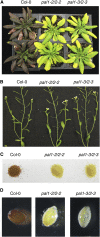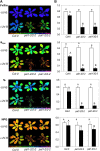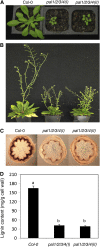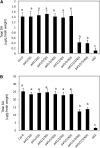Functional analysis of the Arabidopsis PAL gene family in plant growth, development, and response to environmental stress
- PMID: 20566705
- PMCID: PMC2923909
- DOI: 10.1104/pp.110.157370
Functional analysis of the Arabidopsis PAL gene family in plant growth, development, and response to environmental stress
Abstract
Phenylalanine ammonia-lyase (PAL) catalyzes the first step of the phenylpropanoid pathway, which produces precursors to a variety of important secondary metabolites. Arabidopsis (Arabidopsis thaliana) contains four PAL genes (PAL1-PAL4), but there has been no genetic analysis to assess the biological functions of the entire gene family. Here, we report the generation and analysis of combined mutations for the four Arabidopsis PAL genes. Contrary to a previous report, we found that three independent pal1 pal2 double mutants were fertile and generated yellow seeds due to the lack of condensed tannin pigments in the seed coat. The pal1 pal2 double mutants were also deficient in anthocyanin pigments in various plant tissues, which accumulate in wild-type plants under stress conditions. Thus, PAL1 and PAL2 have a redundant role in flavonoid biosynthesis. Furthermore, the pal1 pal2 double mutants were more sensitive to ultraviolet-B light but more tolerant to drought than wild-type plants. We have also generated two independent pal1 pal2 pal3 pal4 quadruple knockout mutants, which are stunted and sterile. The quadruple knockout mutants still contained about 10% of the wild-type PAL activity, which might result from one or more leaky pal mutant genes or from other unknown PAL genes. The quadruple mutants also accumulated substantially reduced levels of salicylic acid and displayed increased susceptibility to a virulent strain of the bacterial pathogen Pseudomonas syringae. These results provide further evidence for both distinct and overlapping roles of the Arabidopsis PAL genes in plant growth, development, and responses to environmental stresses.
Figures









Similar articles
-
Differential expression of four Arabidopsis PAL genes; PAL1 and PAL2 have functional specialization in abiotic environmental-triggered flavonoid synthesis.J Plant Physiol. 2008 Sep 29;165(14):1491-9. doi: 10.1016/j.jplph.2007.11.005. Epub 2008 Feb 1. J Plant Physiol. 2008. PMID: 18242769
-
The phenylalanine ammonia-lyase gene family in Arabidopsis thaliana.Plant Mol Biol. 1995 Jan;27(2):327-38. doi: 10.1007/BF00020187. Plant Mol Biol. 1995. PMID: 7888622
-
The PAL2 promoter activities in relation to structural development and adaptation in Arabidopsis thaliana.Planta. 2012 Feb;235(2):267-77. doi: 10.1007/s00425-011-1506-9. Epub 2011 Aug 27. Planta. 2012. PMID: 21874349
-
Post-translational and transcriptional regulation of phenylpropanoid biosynthesis pathway by Kelch repeat F-box protein SAGL1.Plant Mol Biol. 2019 Jan;99(1-2):135-148. doi: 10.1007/s11103-018-0808-8. Epub 2018 Dec 12. Plant Mol Biol. 2019. PMID: 30542810
-
Biosynthesis of salicylic acid in plants.Plant Signal Behav. 2009 Jun;4(6):493-6. doi: 10.4161/psb.4.6.8392. Epub 2009 Jun 12. Plant Signal Behav. 2009. PMID: 19816125 Free PMC article. Review.
Cited by
-
Transcriptome and metabolite analysis reveal the drought tolerance of foxtail millet significantly correlated with phenylpropanoids-related pathways during germination process under PEG stress.BMC Plant Biol. 2020 Jun 15;20(1):274. doi: 10.1186/s12870-020-02483-4. BMC Plant Biol. 2020. PMID: 32539796 Free PMC article.
-
Feedback inhibition of the general phenylpropanoid and flavonol biosynthetic pathways upon a compromised flavonol-3-O-glycosylation.J Exp Bot. 2012 Apr;63(7):2465-78. doi: 10.1093/jxb/err416. Epub 2012 Jan 16. J Exp Bot. 2012. PMID: 22249996 Free PMC article.
-
Applicability of metabolomics to improve sustainable grapevine production.Front Mol Biosci. 2024 Sep 6;11:1395677. doi: 10.3389/fmolb.2024.1395677. eCollection 2024. Front Mol Biosci. 2024. PMID: 39310375 Free PMC article. Review.
-
Multiomics in grape berry skin revealed specific induction of the stilbene synthetic pathway by ultraviolet-C irradiation.Plant Physiol. 2015 May;168(1):47-59. doi: 10.1104/pp.114.254375. Epub 2015 Mar 11. Plant Physiol. 2015. PMID: 25761715 Free PMC article.
-
Development of a visible marker trait based on leaf sheath-specific anthocyanin pigmentation applicable to various genotypes in rice.Breed Sci. 2019 Jun;69(2):244-254. doi: 10.1270/jsbbs.18151. Epub 2019 Mar 15. Breed Sci. 2019. PMID: 31481833 Free PMC article.
References
-
- Bilger W, Bjorkman O. (1990) Role of the xanthophyll cycle in photoprotection elucidated by measurements of light-induced absorbance changes, fluorescence and photosynthesis in leaves of Hedera canariensis . Photosynth Res 25: 173–185 - PubMed
-
- Boudet AM. (2007) Evolution and current status of research in phenolic compounds. Phytochemistry 68: 2722–2735 - PubMed
-
- Catinot J, Buchala A, Abou-Mansour E, Metraux JP. (2008) Salicylic acid production in response to biotic and abiotic stress depends on isochorismate in Nicotiana benthamiana. FEBS Lett 582: 473–478 - PubMed
Publication types
MeSH terms
Substances
LinkOut - more resources
Full Text Sources
Other Literature Sources
Molecular Biology Databases

